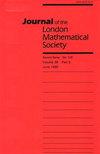Gromov–Witten invariants of bielliptic surfaces
IF 1
2区 数学
Q1 MATHEMATICS
Journal of the London Mathematical Society-Second Series
Pub Date : 2025-02-17
DOI:10.1112/jlms.70081
引用次数: 0
Abstract
Bielliptic surfaces appear as a quotient of a product of two elliptic curves and were classified by Bagnera–Franchis. We give a concrete way of computing their GW-invariants with point insertions using a floor diagram algorithm. Using the latter, we are able to prove the quasi-modularity of their generating series by relating them to generating series of graphs for which we also prove quasi-modularity results. We propose a refinement of these invariants by inserting a -class in the considered GW-invariants.
双椭圆曲面的Gromov-Witten不变量
双椭圆曲面是两条椭圆曲线乘积的商,由Bagnera-Franchis分类。给出了一种利用层线图算法计算其点插入的gw不变量的具体方法。利用后者,我们将它们与图的生成序列联系起来,证明了它们的生成序列的拟模性,并证明了图的生成序列的拟模性。我们建议通过在考虑的gw不变量中插入λ $\lambda$ -类来改进这些不变量。
本文章由计算机程序翻译,如有差异,请以英文原文为准。
求助全文
约1分钟内获得全文
求助全文
来源期刊
CiteScore
1.90
自引率
0.00%
发文量
186
审稿时长
6-12 weeks
期刊介绍:
The Journal of the London Mathematical Society has been publishing leading research in a broad range of mathematical subject areas since 1926. The Journal welcomes papers on subjects of general interest that represent a significant advance in mathematical knowledge, as well as submissions that are deemed to stimulate new interest and research activity.

 求助内容:
求助内容: 应助结果提醒方式:
应助结果提醒方式:


